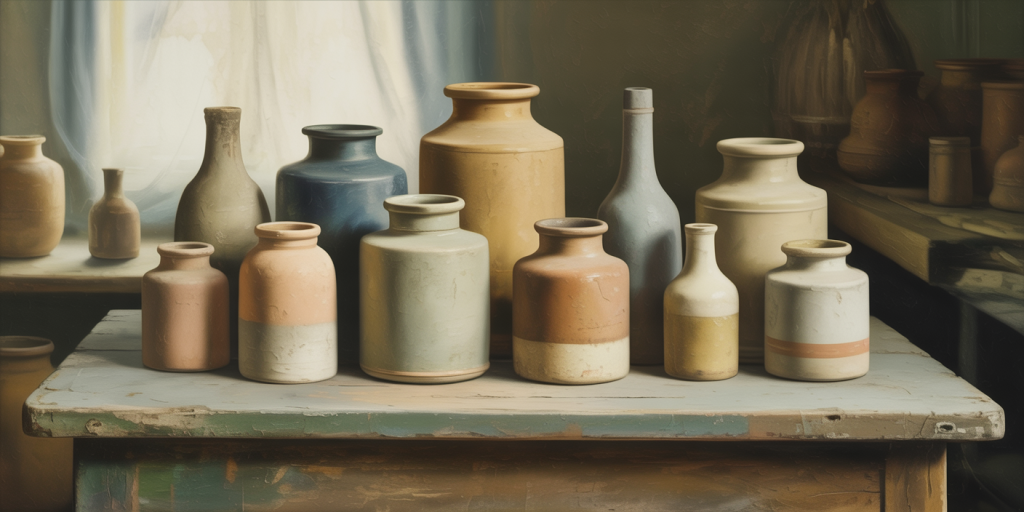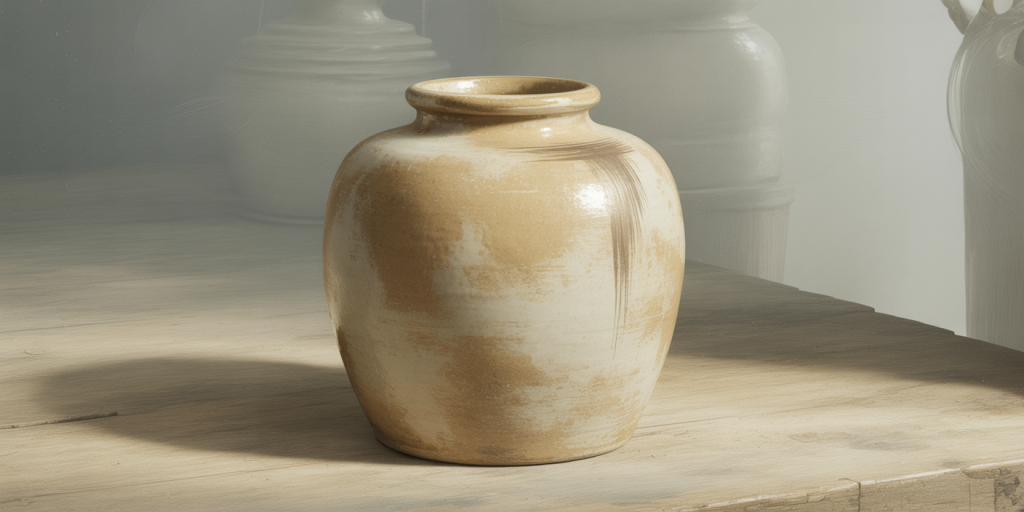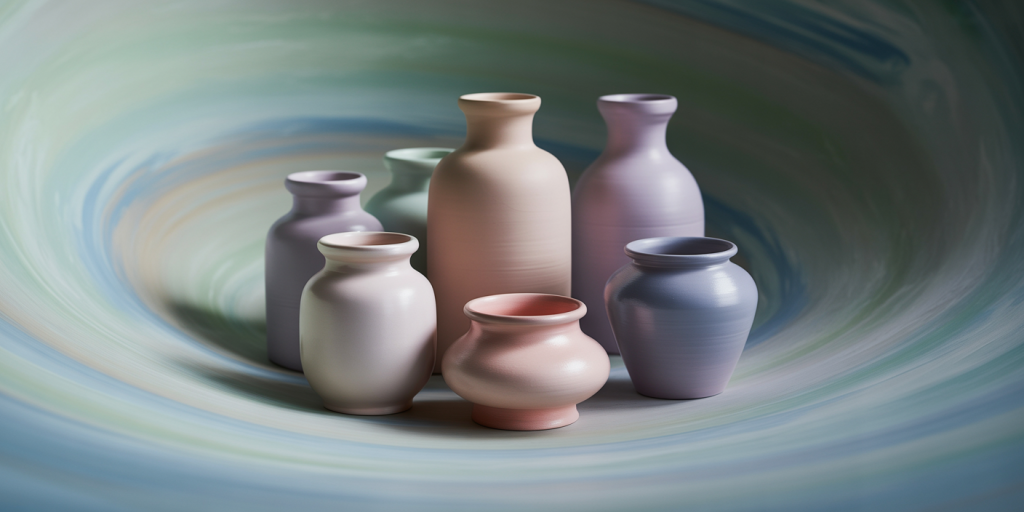The Solitude of the Jar in Morandi’s Pastel Dreams
In a quiet room where time barely breathes, Giorgio Morandi arranged his jars, bottles, and vases like monks at vespers. There is no roar in his canvases, no tumult, no procession of events—only the hush of presence. A jar is no longer a jar, but a relic of memory, an echo of domestic eternity. His works hum with a solitude so fine, so tender, it feels like silk resting on porcelain skin.
In these pastel dreams, the objects do not speak—they listen. They lean, pause, reflect, absorbing light as though it were emotion. Their stillness is not silence but a form of prayer, each pigment a psalm, each composition a whispered revelation. Morandi’s world is not empty; it is filled with the density of introspection.
Table of Contents
- The Whispering Colors of Dust
- Shapes That Lean Toward Eternity
- The Alchemy of Muted Light
- Still Life as a Sacred Ritual
- The Jar as a Vessel of Memory
- The Intimacy of Grays and Beiges
- Shadows that Caress the Form
- Texture as Emotional Topography
- Bottles in Contemplation
- The Architecture of Quiet
- The Spiritual Weight of Emptiness
- Horizon Lines in a Room Without Windows
- Between Presence and Absence
- Objects as Poetic Beings
- Composed Like a Breath
- Melancholy in Matte
- The Domestic Sublime
- When the Light Forgets to Move
The Whispering Colors of Dust
In Morandi’s palette, dust is not decay—it is tenderness. His muted ochres and quiet creams fold into one another like sighs layered in soft cloth. Each hue refuses spectacle, offering instead a nuanced murmur. The colors do not announce themselves; they wait to be noticed, like the voice of a memory long buried under time.
Texture here is inseparable from mood. The powdery finish of his surfaces invites the gaze to slow down. There is no gloss, no sharp contrast—only the velvety sensation of chalk on air, of pigment breathing gently through stillness. The colors seem to age with the viewer, as if they too are remembering.

Shapes That Lean Toward Eternity
Morandi’s shapes are never symmetrical, yet they are deeply harmonious. The jars and bottles, though humble in nature, stand with the dignity of ancient sculptures. Some lean ever so slightly, tilting as if drawn by some invisible grief or longing. Their irregularity makes them human—fragile, contemplative, alive.
Composition is not a matter of arrangement, but of conversation. The objects do not dominate one another but seem to listen, to consider, to respond in silence. Their alignment is not rigid; it’s emotional, almost musical. Like chords in a sonata, they resonate through proximity and pause.
The Alchemy of Muted Light
Light in Morandi’s world is never dramatic, but always reverent. It spills in like a whisper from an unseen window, laying soft veils over the surfaces. This light does not seek to define; it seeks to embrace. There are no harsh shadows, only gradients of affection.
The interplay between light and object is intimate. The jar does not cast a shadow—it receives one. Highlights glow not with brilliance, but with melancholy. It’s as if the light has lived with these objects for years and now mourns their stillness even as it illuminates it.
Still Life as a Sacred Ritual
Morandi’s act of painting was ritualistic. He returned to the same vessels again and again, arranging them with near-liturgical care. Each composition was not just a still life—it was a rite, a moment sanctified by attention. The canvas became an altar where the ordinary was made transcendent.
This repetition was not monotony, but meditation. In the sameness, he discovered the infinite. Slight shifts became revelations. A millimeter of space between objects altered the entire spiritual charge of the work. In this careful choreography, the everyday became eternal.
The Jar as a Vessel of Memory
The jar is not merely an object—it is a guardian of memory. In Morandi’s hands, it becomes a censer of the invisible, holding the scent of time passed. It does not speak of its content, but of the hands that touched it, the cupboards where it slept, the silence it preserved.
Its roundness is maternal, its mouth closed like a secret. Often placed in the background, the jar becomes the soul of the painting—a gentle gravity around which the other elements orbit. Its simplicity is not emptiness but fullness unspoken.
The Intimacy of Grays and Beiges
What others might see as monotone, Morandi revealed as a universe. Within his grays live hints of blue, whispers of green, almost-thoughts of rose. Beige becomes skinlike, a texture one could touch with emotion. These colors are not neutral—they are nuanced, complex, confessional.
He paints not the object but the aura around it. In this, color becomes memory. The beige jar becomes a whisper from childhood, the gray bottle a thought left unfinished. Each tone breathes and pauses, waiting for the viewer to enter its softness.

Shadows that Caress the Form
Morandi’s shadows do not obscure—they reveal. They do not chase away the light, but rest beside it like an old friend. His shadows fall like fabric, folding gently around curves and crevices. They seem to cradle the form rather than define it.
There is a tactility to these shadows. One can feel their weight, their softness. They add dimension not just to space, but to feeling. In Morandi’s world, shadow is not the opposite of light—it is its confidante.
Texture as Emotional Topography
The surface of a Morandi canvas is a terrain of introspection. His brushstrokes are not flamboyant; they are quiet impressions of thought. The texture does not scream—it murmurs. It welcomes the eye to linger, to trace the edges, to feel the hesitation and resolve in each line.
Paint is not applied—it is breathed. The canvas is not a stage but a skin, bearing the invisible pulse of the painter’s inner world. In this way, Morandi’s textures become diaries—intimate, unassuming, and deeply human.
Bottles in Contemplation
Each bottle seems lost in its own reverie. They tilt slightly forward or away, like monks in prayer or lovers unsure of their longing. Their transparency is emotional, not physical. Even when opaque, they seem to reveal something—some ache, some confession.
Their grouping never feels arbitrary. Bottles do not gather; they assemble. Their proximity is charged, as if each one is aware of the other’s presence but afraid to touch. This distance creates a silent music—a harmony of withheld desires.
The Architecture of Quiet
Morandi builds with jars what others build with bricks. His architecture is one of pause and breath. The space between objects is as meaningful as the objects themselves. He constructs cathedrals of quiet, where color and form become sacred geometry.
This quiet is not silence—it is presence. It is the room after the music ends, the stillness after a question is asked but not answered. His compositions are meditations on what remains unsaid, on the architecture of emotion.
The Spiritual Weight of Emptiness
To Morandi, emptiness is not void—it is potential. A jar unfilled holds not absence but promise. The space around the objects throbs with invisible presence. Nothing is just nothing—it is waiting, becoming, echoing.
This weight of emptiness is deeply spiritual. It reflects the human soul—always reaching, always incomplete. In this way, Morandi’s work becomes a theology of lack, a liturgy of longing.
Horizon Lines in a Room Without Windows
Morandi rarely gave us views beyond the table. There were no windows, no distant skies—only the intimacy of a flat horizon. But within this limit, he discovered the infinite. The edge of the table became the edge of the known world.
This subtle line grounded his compositions. It was a threshold—between object and air, between being and becoming. The absence of landscape made room for the internal landscape of the viewer. We look not out, but in.

Between Presence and Absence
Every Morandi painting exists between being and vanishing. The objects are there, and yet, they seem always about to fade. This liminality is not a flaw but a feature—a meditation on the fragile tether between existence and erasure.
This ambiguity creates space for the viewer’s projection. We see not just jars, but ourselves—our solitude, our yearning, our quiet endurance. Morandi’s work becomes a mirror of the inward gaze.
The Pulse Beneath the Paint
Though his canvases are still, they vibrate with an inner pulse. There is movement not in action, but in breath. The air between the bottles trembles with tension, with tenderness. This is the rhythm of reflection.
This pulse is also that of time slowed down. Morandi suspends the clock. We do not look at the painting—we enter it, live in it, forget the world beyond it. It becomes a space where time folds in on itself and feeling takes root.
Objects as Poetic Beings
A jar in Morandi’s world is not merely ceramic—it is metaphor. It holds no water, but meaning. It becomes a symbol for containment, for silence, for self. The object transcends its form and becomes a stanza in a visual poem.
This poetry is not lyrical—it is contemplative. Each object is a word chosen with care, placed not for rhythm, but for reverence. The poem of Morandi’s still lifes is one of essence distilled.
Composed Like a Breath
Every painting by Morandi feels like a single, sustained breath. There is no rush, no climax—only the gentle inhalation of perception and the exhalation of thought. His compositions move slowly, like fog over morning rooftops.
This breath is also the viewer’s. As we stand before his work, our own breath slows. We match the rhythm of the painting, and in doing so, we enter into it—not as observers, but as participants in its calm.
Melancholy in Matte
The matte finish of Morandi’s surfaces is more than aesthetic—it is emotional. There is no shine, no polish—only the raw vulnerability of exposed texture. This matte melancholy is the opposite of spectacle. It draws us not outward, but inward.
We do not see light bouncing—we see it being absorbed. We do not see reflections—we see remembrance. The matte finish becomes a veil, through which the heart can see more clearly.
The Domestic Sublime
Morandi transforms the domestic into the divine. The kitchen becomes a cathedral, the bottle a relic, the table an altar. In this, he reminds us that the sacred is not elsewhere—it is here, among the simple, the overlooked, the quietly persistent.
This sublimity is humble. It does not demand awe—it invites tenderness. It does not dazzle—it dwells. Morandi teaches us to look again at our own lives, and to find in them the profound poetry of the ordinary.
When the Light Forgets to Move
In Morandi’s world, light does not travel—it rests. It lingers as if it has nowhere else to be. This arrested luminosity creates an atmosphere of timelessness. It is not morning, not afternoon—just now, forever.
The result is a dreamscape where the clock dissolves. We are not led forward—we are held still. This suspension is not stagnation but serenity. The light forgets to move, and in that forgetting, we remember how to see.
FAQ
What inspired Morandi’s still lifes?
Morandi found beauty in simplicity and was inspired by the metaphysical nature of ordinary objects. His studio, filled with jars, bottles, and boxes, became a sanctuary for introspective creation.
Why are Morandi’s colors so muted?
His palette reflects a philosophy of restraint and subtlety. The muted tones evoke memory, atmosphere, and emotional nuance rather than spectacle.
What was his artistic technique?
Morandi used oil on canvas with soft, dry brushstrokes. He built his textures slowly, layering paint in a way that created soft, hazy finishes without harsh lines or contrasts.
Is there a symbolic meaning to his objects?
Yes. The jars and bottles often symbolize memory, containment, and introspection. Their stillness reflects deeper emotional and psychological states.
What movement is Morandi associated with?
Morandi is often linked to Metaphysical Painting and Italian Modernism, but his style is highly personal and resists rigid classification.
Notes from a Quiet Table
To enter a Morandi painting is to step into a silence that speaks. His jars and bottles are not inert—they are dreaming. They hold not oil or wine, but echoes of thought, of tenderness withheld, of time suspended like breath in the throat.
Morandi teaches us that stillness is not stagnation—it is revelation. That the quietest objects may carry the loudest truths. That in the solitude of a jar, the universe can unfold, soft as a sigh, sure as a prayer.
